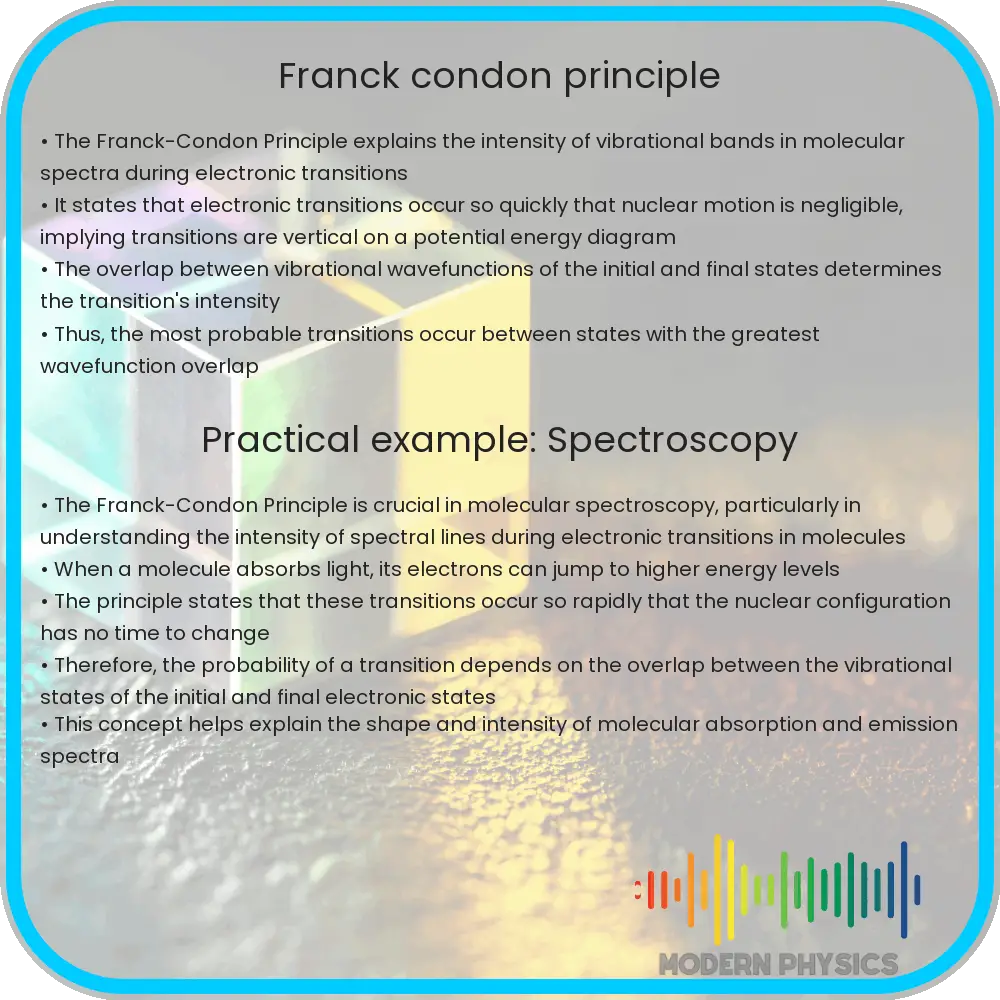Learn about the Franck-Condon Principle, a key concept in quantum mechanics and molecular spectroscopy that explains vibronic transitions in molecular spectra.

Understanding the Franck-Condon Principle
The Franck-Condon Principle is a fundamental concept in the field of quantum mechanics and molecular spectroscopy. It helps explain the intensity distribution of vibronic transitions in molecular spectra, particularly in the electronic excitation observed in molecules. This principle is crucial for chemists and physicists in understanding molecular behavior during electronic transitions.
Quantum Mechanics Basics
Before diving into the Franck-Condon Principle, it’s essential to have a grasp of some basic quantum mechanics concepts. Atoms and molecules have discrete energy levels. When a molecule absorbs or emits photons (light particles), it can transition between these energy levels. The energy of the photon corresponds to the difference between these levels.
Energy Levels and Molecular Vibration
In a molecule, the total energy can be partitioned into electronic, vibrational, and rotational components. Typically, electronic energy changes are much greater than vibrational and rotational. Each electronic state has associated vibrational and rotational levels, forming a complex energy landscape.
The Role of the Franck-Condon Principle
The Franck-Condon Principle focuses specifically on electronic transitions that involve changes in vibrational states. According to this principle, the probability of a transition from one vibrational level to another—accompanying an electronic jump—is greatest when the nuclear configuration of the molecule changes least. This is often summarized by saying that the electronic transitions are “vertical” on an energy diagram.
- Vertical Transitions: In a molecular energy level diagram, vertical transitions imply that during an electronic excitation, the nuclei of the molecule have not had enough time to move appreciably. Physically, this is because electronic transitions occur much faster (on the order of 10-15 seconds) compared to nuclear motion.
Vibronic Transitions and Spectroscopy
Spectroscopy is the study of the interaction between matter and electromagnetic radiation. In the context of the Franck-Condon Principle, it often involves observing the absorption or emission spectrum of a molecule. Each peak in these spectra corresponds to a vibronic transition—the simultaneous change in both vibrational and electronic states of a molecule.
To analyze these spectra, one can use the Franck-Condon factors, which quantitatively describe the intensity of each spectral line. These factors are determined by the overlap between vibrational wavefunctions of the initial and final states, as the more significant the overlap, the higher the transition’s probability.
Mathematically, the Franck-Condon factor between two vibrational states can be represented as:
Fif = |<Ψi | Ψf>|2
Where Ψi and Ψf are the vibrational wavefunctions of the initial and final states, respectively. This mathematical formulation is vital for predicting and understanding the spectral outcomes of molecular transitions.
Application in Real-World Scenarios
The Franck-Condon Principle not only deepens our understanding of molecular spectroscopy but also has practical applications in areas such as chemical analysis, material science, and even astrophysics. By analyzing the spectral data, scientists can infer details about the molecular structure, chemical environment, and the energy changes occurring within the molecule.
For instance, the principle is extensively used in the study of molecular emission in stars, helping astrophysicists determine the composition of distant astronomical objects. In material science, it aids in characterizing the electronic properties of organic photovoltaic materials.
Understanding and Illustrating Franck-Condon Principle
To fully appreciate the Franck-Condon Principle, visualizing the energy transitions graphically can be particularly enlightening. Picture an energy diagram with two electronic states, each having multiple vibrational levels. A vertical line between these states on the diagram represents an electronic transition whereby the vibrational state may change significantly while the nuclei positions remain essentially unchanged. This visualization helps us comprehend the “vertical” nature of electronic transitions in terms of their speed compared to nuclear adjustments.
Experimental Techniques
Experimentally, techniques such as fluorescence spectroscopy and photoelectron spectroscopy make use of the Franck-Condon Principle to interpret their results. In fluorescence spectroscopy, molecules are excited by light to a higher electronic state and the subsequent emission of light as they return to a lower state is measured. The pattern and intensity of this emitted light reveal information about the molecule’s structure and the vibrational energies involved.
Similarly, in photoelectron spectroscopy, electrons are ejected from a molecule by incoming photons and the kinetic energy of these electrons is analyzed. The energies provide insights into both the electronic and vibrational states of the molecule, corroborated by the Franck-Condon Principle.
- Practical Application: These spectroscopic techniques are crucial in the development of new materials, the pharmaceutical industry, and even in environmental monitoring, where understanding molecular composition and behavior is essential.
Conclusion
The Franck-Condon Principle offers a profound yet clear framework for understanding electronic transitions in molecules, which are essential for interpreting molecular spectra across various scientific disciplines. By conceptualizing electronic changes as vertical and rapid, and associating them with vibrational changes, this principle not only explains but predicts the behavior of molecules under electronic excitation. Its relevance spans from fundamental chemistry to applications in astrophysics and materials science, illuminating the intrinsic behaviors of molecules in a universe of complex interactions. As we continue to explore the vast landscape of molecular spectroscopy, the insights provided by the Franck-Condon Principle will undoubtedly play a critical role in shaping our understanding of the material world.
In essence, the Franck-Condon Principle not only bridges our theoretical understanding with practical observations but also enables advancements in technology and science by providing a clearer picture of molecular dynamics and interactions.
